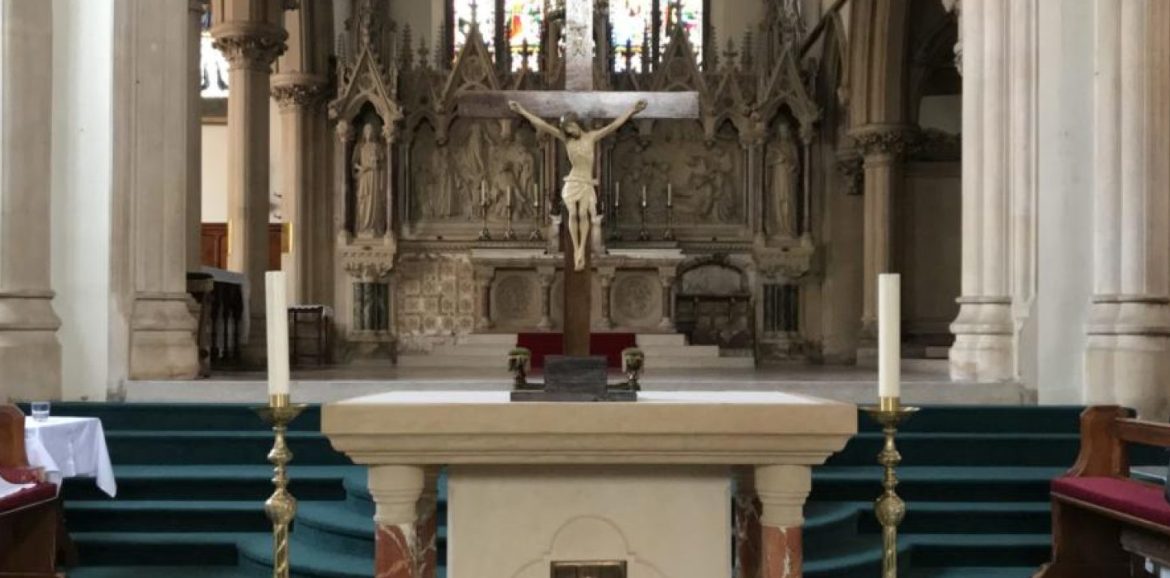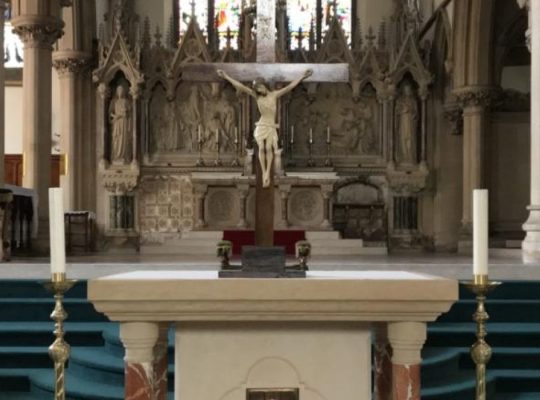Just a Thought
Welcome to the wonderful Feast of the Holy Family. As we gaze into the Crib this Christmas we look upon the model family —the Holy Family, and we are able to contemplate the joys, the sorrows, the glories, the anxieties, but most of all the love that this family experienced; and if we’re wise we should try to emulate them. The Gospels tell us quite a lot of what this little family experienced, but not everything. Tradition will reveal more. After the Nativity and the adoration of the magi, Matthews Gospel tells us of only one event concerning the infancy of Jesus: the flight into Egypt and the return to Israel with the Holy Family’s settling in Nazareth. This incident is read for Year A of the Feast. For Years B and C, the readings are taken from Luke, who relates the stories of the Presentation of Jesus in the Temple and of the three days he remained there when, at the age of twelve, he accompanied his parents on a pilgrimage to Jerusalem. Today we here the narrative of the Presentation of Jesus in the Temple, but both of Luke’s episodes concern Jesus, Mary, and Joseph. The parents presented their newborn child in the Temple to fulfil the prescription of the Law; and some years later discovered that he was not with the caravan returning to Nazareth, after their yearly pilgrimage to the Temple in Jerusalem, but found him three days later seated among the Doctors of the Law. In both these stories attention is focused on Jesus himself. This is the child about whom Simeon and Anna spoke and prophesied. At twelve years of age, he takes the initiative. Moreover, the evangelist recounts Jesus’ first speech, which Mary and Joseph, in their puzzlement, did not understand. The liturgy of Year’s B and C gives the Feast of the Holy Family a different orientation, one more explicitly centered on the person of Jesus and his mission.
From first to last, the life of Christ is obedience to the Father. Coming into the world, he declared: ‘I have come to do your will.’ ‘Born of a woman, born under the Law, to deliver from the Law those who were subjected to it, so that we might receive our status as adopted son’s.’ (Gal 4:4-5) He was circumcised on the eighth day after his birth and, in the following month, his parents took him to Jerusalem to present the prescribed sacrifice to the Lord.
By making this journey, Mary and Joseph conformed to the prescriptions of the Law: ‘Every first born male shall be consecrated to the Lord.’ Mary and Joseph knew their duty here, fully aware that their child belonged to God! Luke reports this episode for its prophetic value. In his Gospel, it is at this point in the Temple where Jesus’ manifestation begins and ends. In some sense, he is enthroned by his parents at the Presentation. There, he is recognised as ‘the Anointed of the Lord’ by two old people—a man and a woman—symbols of all those who live in hope of ‘the consolation of Israel.’
The brief canticle of Simeon proclaims that the mystery of salvation is already accomplished. Like the Magnificat, it is woven with biblical memories that hark back to Isaiah’s ‘Book of Consolation.’ Simeon begins by recognising that the Lord has kept his promises: ‘Now Master, you can let your servant go in peace, just as you promised, because my eyes have seen the salvation which you have prepared for all the nations to see.’ Up till then, God was preparing his salvation : the whole of sacred history is thus evoked. ‘Now’ salvation is given, and even the pagans will participate in it. Jesus, ‘light of the nations,’ has come to bring them his revelation: his mission will later be taken over by the apostles.
‘The child’s father and mother were marvelling at what was being said about him.’ Astonishment is, in the Bible, the normal reaction to revelation: Luke has already noted this in the story of the Annunciation. Its absence signifies either that one is blind to the presence of divine mystery or, because it has been heard or celebrated so often, that it has become rather blasé.
Until that time, Jesus had only been hailed as the Messiah for Israel. It is another matter to recognise him as the salvation of the pagans. Luke, in his Gospel and in Acts, insists on this point, he knows that it goes against the grain to acknowledge this universalism and put it into practice.
After Simeons prophetic song, Simeon turns to Jesus’ parents in order to bless them and to give thanks to God for what he has done and will do for and through them. This benediction is in the form of a ‘Beatitude’, similar to what Elizabeth used to address Mary. But that is not all. Simeon suddenly sees in the child a sign of division: he will cause the fall and rise of many in Israel; foundation for the edifice of salvation, he will be a stumbling block for.
Speaking directly to Mary, Simeon says: ‘And you yourself shall be pierced with a sword.’ What is the personal trial to which he speaks? Tradition suggests it is the Dolores of Mary of which he speaks—her sorrows. Others think Simeon was talking about Mary’s involvement in the trials of her son, who was so harshly opposed during his mission, the object of slander, misunderstanding etc. Simeon says that Jesus will become ‘a sign to be contradicted.’ Mary the believer is troubled; she wonders, she is astonished, and she questions, she does not understand, and she reflects and meditates on the mystery. The sword that cleaves the people of God asunder has struck this daughter of Zion personally.
The story ends with Anna’s intervention. She approaches and ‘the praises of God’ sung by the angels at Jesus’ birth resound in the Temple as Jesus is about to enter. Then Anna, ‘a prophetess,’ takes over so to speak, from the shepherds at Bethlehem, and begins to speak of the child ‘to all who looked forward to the deliverance of Jerusalem.’ The Presentation of Jesus at the Temple is truly the Feast of Encounter, as the Eastern church calls it. ‘O God, we ponder your kindness within your Temple. As your name O God, so also your praise reaches the ends of the earth.’
‘When the pair had fulfilled all the prescriptions of the Law of the Lord, they returned to Galilee and their own town of Nazareth.’ A long period of silence begins for the Holy Family. They will lead a humble and hidden existence that has never been revealed. (Although through Tradition a certain amount can be known). The Gospel though, only reports that ‘his parents used to go every year to Jerusalem for the Feast of the Passover’ and what happened when ‘they went up for the celebration as was their custom’ when he was twelve years old. Luke contents himself with noting that ‘the child grew in size and strength, filled with wisdom, and the grace of God was upon him.’ Once again, we can see here the parallelism between Jesus and John the Baptist that characterises Luke’s infancy narrative. About John he writes: ‘The child grew up and matured in spirit, he lived in the dessert until the day when he made his public appearance in Israel’ The difference between these two accounts are significant. Jesus, conceived by the Holy Spirit, is ‘filled with wisdom.’ Wisdom, understood in its primary scriptural sense, truly belongs to Jesus. Luke repeats this several times—Is it not in harmony with the Spirit? Again, while John goes into the desert early on, Jesus remains with his family, sharing the life of the people of Nazareth until the very beginning of his ministry. Unlike John, he does not wait for someone to come to him: he announces the good news on the roads and in public places, in synagogues and houses.
This years Feast of the Holy Family shows the child Jesus borne in the arms of Mary, accompanied by Joseph. Simeon and Anna, two old people, are enlighten by the Holy Spirit and recognise the child as the Messiah for whom they have waited. No angelic intervention is involved here, but rather a man and a woman animated by intense longing. It is enough: their eyes see the coming of God, the object of their lifelong hope.
This year’s focus does not bear directly on the example of familial virtue suggested by the Holy Family, but primarily on the fact that faith and the Spirit allow one to recognise the presence of the Lord among us, however humble and inauspicious it may appear. Having said that it is obvious to us that each member of the Holy Family is involved in todays Gospel.
Another fact needs our attention. The encounter of Simeon and Anna with Jesus took place on this occasion of his presentation. Mary and Joseph made the journey in order to satisfy a prescription of the Law. They planned to go to the Temple in Jerusalem, make the customary offering and then return home. Imagine their astonishment when they saw this stranger approach, an old man who took the child in his arms, blessed them, and said the most extraordinary things. Their surprise, no doubt increased when they saw Anna the prophetess approach proclaiming the praises of God. Their situation was ordinary enough, a journey made by hundreds of other families without anything unusual happening. Then all of a sudden the unforeseen and the unforeseeable come to light. An encounter takes place. A word, indeed a revelation, is given that God clearly intends for us. At the same time it allows others to perceive the hidden Lord.
Exceptional grace belonging to exceptional people? Certainly not, for it is God who guides our steps and those of others. We have nothing it is true. But the One who gave Abraham a posterity can bring the most extraordinary bounty out of the simplest actions. Faith and obedience to God can work wonders, often when we least expect it.
As we contemplate the crib this Christmas, let us realise that the Feast of the Holy Family is not just another devout votive celebration, or just a minor addition to the liturgical calendar, but rather, that it is a major contribution toward helping us to understand the mystery of the Lord’s Nativity, and to give to us the example to model our own families on.


